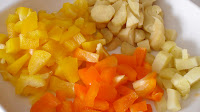Perk up a cold mid-winter evening with the enervating colours and comforting aromas of this pureed soup.
 |
| Beet, parsnip and sweet pepper soup |
 |
| Cooked beet, purple potato and carrot |
Ingredients (red soup):
½ teaspoon coconut oil
½ cup chopped red onion
½ clove garlic, crushed
1 small beet, steamed, peeled, chopped
½ carrot, steamed, peeled, chopped
2 purple potatoes, steamed, peeled, chopped
1 cup beet stock or chicken stock
 |
| Cooked and diced ingredients for the yellow soup |
Ingredients (yellow soup):
½ teaspoon coconut oil
½ cup chopped white onion
½ clove garlic, crushed
1 parsnip, steamed, peeled, chopped
1 white potato, steamed, peeled, chopped
½ yellow sweet bell pepper, diced
¼ orange sweet bell pepper, diced
1 cup chicken stock
Garnish:
1 sprig cilantro
Preparation :
1. Use two saucepans. You will cook in both pots at once, treating each mixture separately. Melt ½ teaspoon coconut oil in each pot. Place red onion and garlic in one (the red pot), and white onion and garlic in the second (the yellow pot).
2. To the red pot, add all items listed under Ingredients (red soup).
 |
| Beet soup (red pot) |
3. To the yellow pot, add all items listed under Ingredients (yellow soup).
 |
| Parsnip and sweet pepper soup (yellow pot) |
4. Simmer both mixtures for 10 minutes.
5. Decant the contents of the red pot into a blender. Pulse at high speed until the mixture is thoroughly pureed. Pour the red puree back into the red pot and reheat over low heat.
 |
| Beet puree |
6. Thoroughly wash the blender, then decant the contents of the yellow pot into it. Pulse at high speed, as you did with the red mixture. Pour the yellow puree into the yellow pot and reheat. At this point, you may wish to add salt, pepper or other preferred seasonings to each puree.
 |
| Parsnip and sweet pepper puree |
8. Ladle ¾ cup red puree into one measuring cup and ¾ cup yellow puree into another measuring cup.
9. Simultaneously, pour into a soup bowl from both measuring cups to create the effect shown in the illustration above. Garnish with a sprig of cilantro.
































